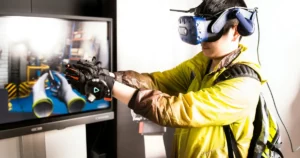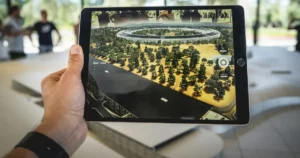AR/VR is revolutionizing software development, offering new ways to create interactive and immersive experiences. From augmented reality applications enhancing user interfaces to virtual reality environments enabling advanced simulations, these immersive technologies are redefining development practices. Explore how mixed reality is bridging the gap between virtual and physical worlds.
[ez-toc]AR/VR: A Game Changer or Niche Market for Software Companies?
Traditional flat-screen interfaces are giving way to immersive experiences powered by Augmented Reality (AR) and Virtual Reality (VR). This opens exciting opportunities for software companies to create applications that are not only functional but truly engaging.
For instance, AR applications are now common in retail, where they enable customers to visualize products in their own space before making a purchase. VR is used for creating simulations and training programs that offer hands-on experience in a controlled environment.
Thus, the relevance of AR and VR for software companies is rapidly evolving. While not a mandatory pivot for every company, it offers significant potential for those who embrace it strategically. Here’s a breakdown:
Why AR/VR is Relevant
- Market Growth: The AR/VR market is projected to reach a staggering $80.5 billion by 2025 [1]. This explosive growth suggests a significant opportunity for software companies to innovate and capture market share.
- Enhanced User Engagement: AR/VR allows for immersive experiences that go beyond traditional flat screens. This can lead to increased user engagement, improved brand loyalty, and ultimately, higher revenue.
- Untapped Potential: AR/VR is still in its early stages, offering a wide range of possibilities across various industries. Early adopters can establish themselves as thought leaders and create entirely new revenue streams.
- Companies in Training & Simulation: AR overlays can revolutionize training by providing interactive and efficient learning experiences.
- Gaming Companies: AR/VR can create entirely new gaming experiences, fostering deeper player engagement and driving sales of VR headsets.
- Marketing & E-commerce Companies: AR allows for interactive product visualization, leading to more informed purchases and boosted sales.
- Companies with Complex Products: AR can provide step-by-step assistance for assembly or maintenance procedures, enhancing customer satisfaction.
- Companies with Simple, Straightforward Products: If your product doesn’t benefit from extensive visualization or complex training procedures, AR/VR might not be a priority.
- Companies with Limited Resources: Developing and maintaining AR/VR applications requires specialized skills and resources. Carefully assess your budget and expertise before diving in.
Pivot or Strategic Investment?
A complete pivot to AR/VR might not be necessary for every company. However, a strategic investment can be incredibly beneficial. Here’s how:
- Start Small: Begin by exploring pilot projects or AR/VR prototypes in specific areas of your business where the technology can add significant value.
- Develop Expertise: Consider building an internal AR/VR development team or partnering with experienced AR/VR development firms.
- Focus on User Needs: Don’t get caught up in the hype – ensure your AR/VR applications solve real problems and address user needs effectively.
Don’t be mistaken: the future is immersive. But, while not every company needs to become an AR/VR pioneer, understanding its potential and strategically incorporating these technologies can be a significant advantage in software development too. Let’s move forward to examples where it is desired.
Mixed Reality: The Best of Both Worlds
Mixed reality (MR) combines elements of both AR and VR, creating a hybrid environment where physical and digital objects interact in real time. Include Developers are exploring MR to create applications that can seamlessly integrate digital content into the real world, enhancing both user experience and functionality. This technology is particularly beneficial in fields like architecture and engineering, where precise visualizations are crucial.
Forget Flat Screens, It’s All About Immersive Experiences: 3 Examples and How-Tos

VR user interaction focuses on creating a sense of presence within the virtual world. Photo by XR Expo.
AR and VR are prompting software companies to rethink application design. By embracing these immersive technologies, software developers can create:
- Training simulations that are as real as it gets – think faster learning, fewer errors, and a happier workforce.
- Games that transport players to entirely new worlds – get ready for deeper engagement and a booming industry.
- Marketing campaigns that break the mold – boost customer engagement and watch sales soar.
Here’s how AR/VR is transforming software design across various sectors, along with the technical considerations for development, all wrapped up with some inspiring examples.
1. Training Gets a Reality Check (and VR Goggles)
AR and VR are revolutionizing training programs by providing immersive environments where users can practice skills in a safe, controlled setting. Simulation applications in VR provide detailed, realistic environments that can replicate complex scenarios, such as flight simulators for pilot training or emergency response drills for disaster preparedness.
Industries such as healthcare and education are increasingly adopting VR to enhance learning and training outcomes. Imagine a world where:
- Factory workers don AR glasses and see interactive overlays highlighting assembly procedures for complex machinery – no more bulky manuals or confusing diagrams. Studies by Deloitte even suggest AR-based training can slash training time!
- Surgeons hone their skills in hyper-realistic VR simulations, practicing intricate procedures before ever stepping into an operating room. Reports estimate VR training in healthcare can lead to significant improvement in surgical skills – talk about a game-changer!
The Challenge: Imagine a factory worker struggling to decipher a complex equipment assembly manual. Traditional training methods often rely on manuals and classroom sessions, which can be time-consuming and ineffective.
The AR/VR Solution: AR overlays can revolutionize training by providing step-by-step instructions directly in the worker’s field of vision. Take, for example, Boeing’s use of AR to train mechanics on complex airplane wiring systems. AR overlays highlight specific components and procedures, eliminating the need for bulky manuals and improving knowledge retention.
Technical Considerations:
- Development Tools & Frameworks: Building AR training applications often utilizes game engines like Unity or Unreal Engine, which offer robust AR development functionalities.
- Team Skills: The development team should have expertise in 3D modeling, animation, and user interface (UI) design principles specifically for AR environments.
Benefits:
- Reduced training time (studies suggest up to 80% reduction with AR)
- Improved knowledge retention for trainees
- Enhanced safety through risk-free practice scenarios in a virtual environment
2. Gaming Goes Beyond the Controller and into Immersive Worlds
Gaming is one of the most popular applications of AR and VR, offering players immersive experiences that blur the lines between the digital and physical worlds. Developers are creating more interactive and engaging games that leverage the full potential of these technologies, providing unprecedented levels of immersion and interactivity.
Remember Pokemon Go? That location-based AR phenomenon that had everyone glued to their phones, exploring the real world to catch virtual creatures? It’s a perfect example of how AR can transform gaming, and the industry is booming. Statista predicts the number of AR & VR market users will reach 3,728.0m users by 2029. Buckle up, gamers, the future of play is here!
The Challenge: Remember being glued to your phone hunting for virtual creatures in Pokemon Go? That’s AR in action! But traditional gaming experiences are often confined to the limitations of a screen.
The AR/VR Solution: AR and VR can transport players to entirely new worlds, fostering deeper engagement and a more interactive experience. Imagine exploring the fantastical landscapes of Skyrim in VR, or using AR to battle virtual monsters in your living room with your friends.
Technical Considerations:
- AR Gaming: Developing AR games requires expertise in location-based services (LBS) integration, AR frameworks like ARKit (Apple) or ARCore (Google), and real-time computer vision to process user interactions with the physical world.
- VR Gaming: Building VR games necessitates a deep understanding of 3D graphics programming, physics engines, and VR user interaction design. Popular game engines like Unity and Unreal Engine offer powerful tools for creating immersive virtual worlds, with additional libraries like SteamVR or Oculus SDK enabling interaction with specific VR headsets.
- Increased player engagement and immersion, like feeling like you’re truly exploring a virtual world
- Entirely new gameplay mechanics and possibilities, like battling virtual creatures in your living room
- Growth potential in a booming AR/VR gaming market
3. Marketing Gets a Makeover (with a Dose of Reality)
In marketing, AR and VR are used to create engaging campaigns that allow consumers to interact with products in new and exciting ways. For instance, AR can enable customers to see how furniture would look in their homes, while VR can provide immersive tours of real estate properties or virtual test drives of cars.
AR can also be a marketer’s best friend. Imagine customers virtually trying on clothes before buying, or seeing how furniture would look in their living room without leaving the comfort of their couch. This kind of interactive product visualization is a surefire way to boost engagement and sales – consumers are more likely to buy from a brand that offers AR experiences.
The Challenge: Static product images and videos can struggle to convey the true functionality or scale of a product. Imagine a customer trying to decide if a new couch will fit in their living room based on a single photo.
The AR/VR Solution: AR allows customers to virtually try on clothes, visualize furniture in their homes, or explore the features of a product in a 3D space. Ikea Place, for example, is a popular AR app that lets users virtually place furniture in their homes to see how it would look before they buy. This interactive approach fosters a deeper connection with the product and significantly impacts purchasing decisions.
- Development Tools & Frameworks: AR marketing experiences require expertise in 3D modeling of products, marker-based or markerless object recognition, and real-time image processing to seamlessly blend virtual elements with the real world. Frameworks like ARKit and ARCore are essential for this purpose.
- Increased customer engagement with products, like virtually trying on clothes before you buy
- Improved product visualization and understanding, like seeing how furniture would fit in your living room
- Boosted sales and conversion rates by allowing customers to make informed purchasing decisions
Overall, AR and VR introduce a new layer of complexity to the software development environment. However, the potential for creating truly immersive and engaging user experiences makes it a worthwhile investment for companies looking to push the boundaries of software development.
AR and VR vs. Software Design and Development

Developers are using augmented reality to overlay digital information onto the physical world, integrating virtual elements with the real world captured through the device’s camera. Photo by Patrick Schneider.
By leveraging augmented reality and virtual reality, developers are creating more engaging and interactive applications. These immersive technologies are not just transforming user experiences but also enhancing the development process itself. But, from a software development standpoint, AR and VR present distinct challenges and require different approaches.
The development process for traditional applications can be complex, but it follows established methodologies and utilizes well-understood technologies. Meanwhile, AR/VR development is a relatively new field with ongoing advancements. The development process can be more complex due to the need for specialized skills, tools, and continuous adaptation to evolving technologies.
Regular Software |
Augmented Reality |
Virtual Reality |
|
Development Tools and Languages |
Software developers primarily rely on high-level programming languages like Java, Python, or C++ to build traditional applications with a focus on functionality and user interface design for a 2D screen. | AR development often builds upon existing mobile or tablet interfaces, integrating virtual elements with the real world captured through the device’s camera. This means developers may leverage familiar tools and languages like Swift or Kotlin (for iOS) and Java or Kotlin (for Android) alongside AR frameworks like ARKit or ARCore. | VR development requires building an entirely virtual environment. Developers need expertise in 3D graphics programming languages like C# or C++, along with game engines like Unity or Unreal Engine that offer robust VR development functionalities. VR applications also need to consider user interaction within the virtual world, requiring additional libraries like SteamVR or Oculus SDK depending on the target VR headset. |
User Interaction |
User interaction primarily involves keyboard, mouse, or touchscreen input for navigating menus, buttons, and other UI elements on a flat screen. | User interaction in AR primarily happens through the device’s touchscreen or buttons, similar to traditional mobile apps. However, AR can also incorporate location-based services (LBS) and real-time computer vision for more immersive interactions. | VR user interaction focuses on creating a sense of presence within the virtual world. Developers need to consider how users will move around, manipulate objects, and interact with virtual elements. This often involves integrating VR controllers, motion tracking sensors, and head-mounted displays (HMDs) to capture user movements and translate them into the virtual environment. |
Performance Optimization |
Software optimization focuses on efficient code execution and memory management for smooth performance on various devices. | AR applications need to be optimized for smooth performance on mobile devices, balancing the processing power required for AR features with battery life considerations. | VR applications require significant processing power to render high-fidelity 3D graphics and maintain a smooth frame rate to avoid motion sickness in users. Developers need to optimize VR applications for powerful VR headsets or high-end PCs. |
User Interface (UI) Design |
UI design principles focus on clarity, usability, and intuitive navigation within a 2D interface. | AR UI elements should be subtle and unobtrusive, seamlessly blending with the real world. Information needs to be presented clearly and concisely to avoid overwhelming users. | VR UI elements can be more immersive, integrating with the virtual environment itself. However, they still need to be intuitive and easy for users to understand and interact with within the VR space. |
In summary, AR and VR development require different skillsets and approaches. Understanding these distinctions is crucial for software companies venturing into the exciting world of immersive technologies.
The Team You Need
Overall, AR and VR introduce a new layer of complexity to the software development environment. However, the potential for creating truly immersive and engaging user experiences makes it a worthwhile investment for companies looking to push the boundaries of software development.
Not sure where to start building your AR/VR or AI dream team? UbiInds can help! We specialize in connecting software companies with the most qualified AR/VR and AI talent to bring your innovative projects to life. Reach us in the form below to learn more!

International Marketing Leader, specialized in tech. Proud to have built marketing and business generation structures for some of the fastest-growing SaaS companies on both sides of the Atlantic (UK, DACH, Iberia, LatAm, and NorthAm). Big fan of motherhood, world music, marketing, and backpacking. A little bit nerdy too!



